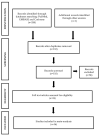T-Score and Handgrip Strength Association for the Diagnosis of Osteosarcopenia: A Systematic Review and Meta-Analysis
- PMID: 34204622
- PMCID: PMC8231129
- DOI: 10.3390/jcm10122597
T-Score and Handgrip Strength Association for the Diagnosis of Osteosarcopenia: A Systematic Review and Meta-Analysis
Abstract
Background: Osteosarcopenia is a recently identified condition caused by the coexistence of osteoporosis and sarcopenia that affects the frail elderly population, leading to an increased risk of falls and fractures. Given the recent socio-economic interest associated with osteosarcopenia, the aim of this meta-analysis is to provide an overview of the factors potentially involved in its pathogenesis, assessing its population type, prevalence, and associated variables.
Methods: A comprehensive systematic search for relevant studies, published from 2015 to 2020, was performed by using PubMed, EMBASE, and Cochrane databases. We analysed the variables of age, vitamin D, handgrip, and T-score in four different groups: healthy, osteopenic-osteoporotic, sarcopenic, and osteosarcopenic.
Results: A total of 6504 patients from 16 studies were included in the final meta-analysis. The analysis of the individual variables reveals a statistically significant correlation between the handgrip test data and T-score (p < 0.001).
Conclusions: The correlation between T-score values and handgrip strength suggests a new potential parameter in the development of predictive models that could be used in clinical practice, highlighting its importance for the diagnosis of osteosarcopenia.
Keywords: T-score; handgrip strength; meta-analysis; osteoporosis; osteosarcopenia; sarcopenia; systematic review.
Conflict of interest statement
The authors declare no conflict of interest.
Figures




References
-
- Martin F.C., Ranhoff A.H. Frailty and Sarcopenia. Springer; Cham, Switzerland: 2021. pp. 53–65. - PubMed
Publication types
Grants and funding
LinkOut - more resources
Full Text Sources

